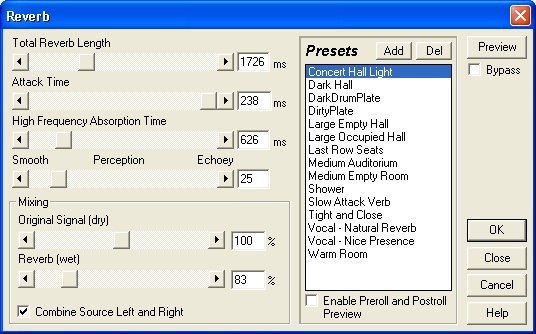Reverb Effects
Reverberation can be added to a sound artificially using a reverb effect. This effect can be generated by a stand-alone reverb unit, the reverb effect in another device (such as a mixer or multi-effects unit), or by audio processing software.
There are three possible reasons for adding reverb:
- To restore the natural sound as the listener would expect to hear it. For example, a recording done in a very low-reverb studio might sound unnatural unless reverb is added.
- To enhance the sound. For example, it is common to give vocal recordings more reverb than what would be considered natural. Reverb helps fill out the voice, giving it more "body" and is usually considered to be a flattering effect. Reverb can even help smooth minor vocal fluctuations so they aren't as obvious.
- To create special effects such as dream sequences, etc.
Reverb is the most common audio effect, partly because it is used in so many situations from music studios to television production. Every sound operator should have a good understanding of reverb and how/when to apply it.
It pays to be judicious with reverb. Because it is so effective, it can easily be over-used. The right amount of reverb can do wonders for a singer's voice but too much sounds silly.
Examples
The photo below is a rack-mountable Lexicon PCM 81 Digital Effects Processor. This unit has a number of effects including reverb.
The screenshot below is from Adobe Audition, a sound editing package. It gives you an idea of some of the common reverb settings. Notice how most of the presets are described by the real-world effect they are simulating, for example, "Concert Hall" and "Medium Empty Room". This is common in reverb units.

See also: